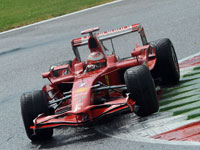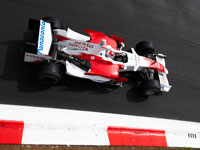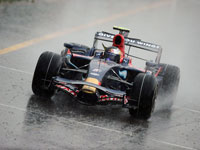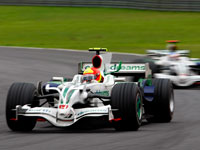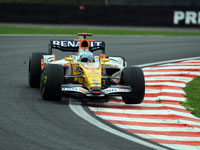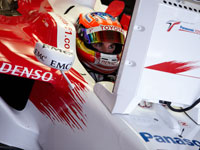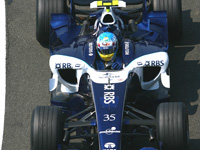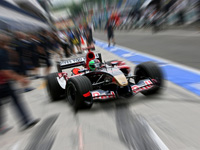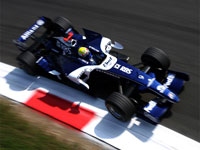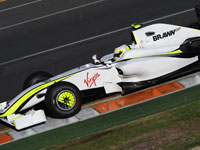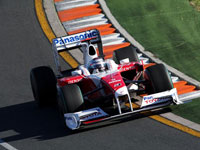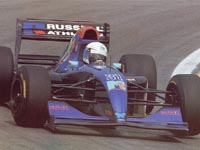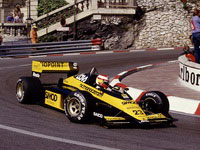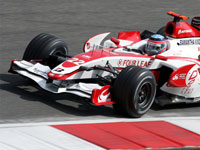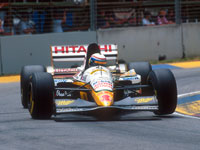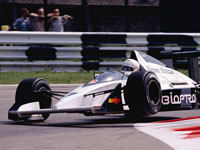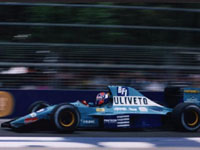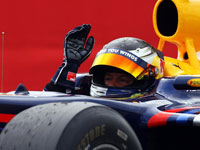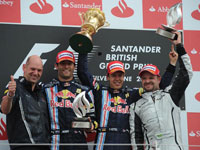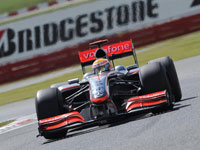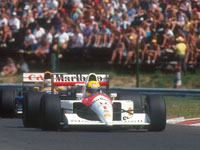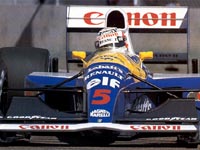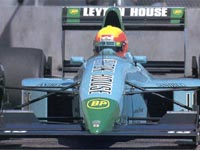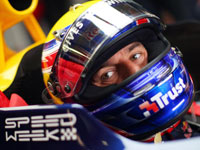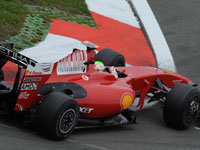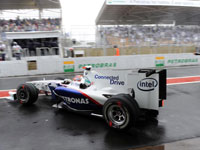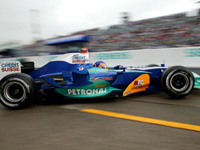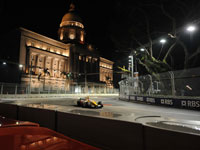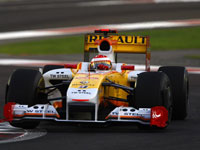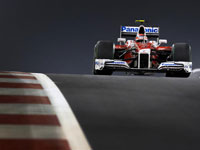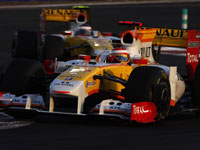Poachers turned gamekeepers: how the FOCA became the new FIA
Part 8: Encore – from Ferrari International Assistance to FIA’s Intrepid Adversary
Author
- Mattijs Diepraam
Date
- October 26, 2009; updated on November 4, 2009, and December 20, 2009
Related articles
- Poachers turned gamekeepers - How the FOCA became the new FIA, by Mattijs Diepraam
- Part 1: Introduction and FIASCO war timeline
- Part 2: Onset – authority and rebellion
- Part 3: 1979-1980 – the FIA on the counter attack
- Part 4: 1981 – long live the FIA F1 World Championship
- Part 5: 1982 – all is fair in love and war
- Part 6: Aftermath – the rebels become the establishment
- Part 7: Present day – a new twist to the story
Who?Jenson Button, Rubens Barrichello What?Brawn-Mercedes BGP001 Where?Melbourne When?2009 Australian GP (March 29, 2009) |
 |
Why?
July 29, 2008, was to become another milestone date in the history of F1 politics. It was the day that the formation of a Formula One Teams Association was formally announced, and everyone in the know sensed there was more trouble ahead. To begin with, the name harked back to the Formula One Constructors Association of yore, founded in order to form a united front against extortionate race organisers but eventually handed free reign to become the extortioner itself. However, whereas the then ‘grandee’ teams of Ferrari, Renault and Alfa Romeo never joined the FOCA, the new twist was that all current F1 teams would be members of FOTA – both manufacturer-owned and independents.
As with the original Concorde Agreement, its place of birth was Maranello, and Ferrari would take a leading role in the new organisation. “Ferrari are absolutely key”, said erstwhile Honda F1 boss Nick Fry. “Ferrari are extremely important to F1”, echoed John Howett of Toyota, the FOTA’s new vice-president.
The teams signed off the Articles of their association a couple of months later, on September 11 at Monza, ahead of the Italian GP. It happened amidst all the controversy over Lewis Hamilton’s pass of Kimi Räikkönen at Spa and his subsequent time penalty which handed victory to the Finn’s team mate and Hamilton’s main title challenger Felipe Massa. Hamilton fans and Ferrari critics reacted to the decision by accusing the FIA of favouritism – again. The furore reached such heights that it even moved FIA president Max Mosley to officially deny a FIA agenda of the sort. Given the recent past, however, you could see where claims of the FIA being no less than a Ferrari International Assistance came from.
Six months into the future people were talking about Ferrari as FIA’s Intrepid Adversary, the Italian company leading a very serious attempt at breaking away from FIA’s governance of the sport. What had happened?
Initially, FOTA looked well set to thrash out a new set of rules with the FIA. Indeed, Mosley invited the new body to discuss his cost-cutting proposals after the Chinese GP, having had a “constructive meeting” with Ferrari president and FOTA chairman Luca Di Montezemolo.
A “landmark meeting” held in Geneva on October 21, 2008, led to a broad agreement between FIA and FOTA about significant cost-cutting measures for 2009 and 2010 covering four key points: increased engine life from two to three races from 2009, 25 engine units to be made available to customer teams at a cost of 10 million euros, a further meeting in Brazil to determine testing limits for 2009 and the introduction of a standard KERS in 2010 or 2011, and finally renewed talks about cheaper chassis development or even the re-introduction of customer chassis in the future. The very same day, however, Mosley claimed that he still wanted to push forward with his plans for a spec engine. These were announced just ahead of the Geneva meeting and sent shockwaves through the FOTA ranks, since engine technology is precisely what makes F1 different from other categories in the sport, the manufacturers argued.
Earlier, at Monza, right after the FOTA “constitution” was laid down, one team owner was quoted as FOTA’s number-one supporter. “FOTA will represent the teams; it will set the rules, working with the FIA; it will establish commercial criteria. FOTA is very important to the future of Formula One.” It is perhaps significant that these words were spoken by Ron Dennis. Even though Ferrari and McLaren were on speaking terms again, even in the middle of the Spa fall-out, the relationship between the McLaren team boss and the FIA president was still freezing cold. And while the only talk up until the 2008 Christmas holidays centered around technical and regulatory issues, the small insertion by Dennis about the FOTA “establishing commercial criteria” would prove very significant into 2009.
One day ahead of receiving Mosley’s letter to the teams, on October 19, Ron Dennis even went as far as to state the following: "We are strong and together, but we are not a threat. We are looking at being constructive to F1, and we don't have any motive other than to address the issues we had six months ago and starting to emerge from a difficult economic situation that has yet to impact on F1."
When the dust finally settled down well into the 2009 season, FOTA had turned out to be a huge threat to the FIA’s power, and in many ways got their way – technically, commercially and personally. Still, Mosley wasn’t going down by himself: he would take the worst of his foes with him…
Spec engine
As we said earlier, the argument was technical at first. Landmark agreement or not, one particular item in the FIA proposal to the teams kept standing out: the spec engine. Initially, the teams thought this was a classic Mosley ploy, bargaining for more than he would eventually be pleased with. If they would agree to some of Mosley’s cost-cutting proposals he would surely drop the spec engine. In the end he would but in a way that led to even more turmoil.
A week after the FIA proposal and the initial agreement with the teams, Toyota boss John Howett let it be known on behalf of the teams that the spec engine – whether it be made by a single supplier or, alternatively, by each manufacturer themselves – would be enough reason to pull out of the sport. Speaking for Toyota he said that for now the Japanese manufacturer was committed to staying in F1 but his remarks sparked a further increase in rumours that Toyota was about to swap F1 for a renewed attempt at winning Le Mans. The very same day Mosley responded by stating that he was pushing through with the tender and that several parties had already shown an interest in supplying the engine. He was for real: the application forms were there, on the FIA site.
Undeterred, the FOTA pushed through with its own cost-cutting plans, confident that these would offset any gains made by implementing a standard engine. These included five-million-dollar customer engine deals, and a low-cost engine by 2011, based on what many believed to be a 1.8-litre turbo formula featuring KERS and low fuel consumption. That was all fine and well, Mosley argued, but these engines would still be supplied by manufacturers that could leave the sport at any time. Actually, he was aware of several manufacturers being on the brink of doing so at the end of the 2008 or perhaps 2009 season. With the threat of not enough engines going around to fill the grid, there would still be a need for an independent supplier of a cost-effective and competitive engine – bring on the winner of FIA’s spec-engine tender.
Mosley’s warning turned into harsh reality on December 5 when Honda made the shock announcement that it was to withdraw from F1 with immediate effect. Using the tide, the FIA president warned that more manufacturers could follow, and the paddock buzz soon centered around Toyota and Renault. Pulling the rabbit out of his hat on the very same day, he announced that the FIA had reached a deal with Cosworth and gearbox specialists Xtrac and Ricardo Transmissions – in a consortium called XR – to supply full F1 powertrains at an annual cost less than 6 million pounds. These costs would drop further if more than four teams would sign up for the engine. Teams building their own engines to spec would have to use the XR transmission and an equalisation procedure would ensure the level performance of both the Cosworth and the manufacturer engines. A standard engine, Mosley further argued on December 10, would go to stabilize F1 – a day before the FIA deadline for signing up for the Cosworth engine would pass. Not just Williams was said to have shown an interest but Red Bull and Toro Rosso as well, and surprisingly, Renault too. This even led to a statement in which Renault denied it was going to separate from FOTA.
The question of money
A few days earlier, the FOTA had brought money back into the equasion. Recognizing the need for cost cuts, it also looked at the revenue side of their books. Their operations would become healthier not just by spending less but also by earning more, as they dragged Bernie Ecclestone of Formula One Management (FOM) and Donald McKenzie of F1’s commercial rights holder CVC into the discussion. Was this the cat coming out of the bag?
Meanwhile, a day ahead of the Cosworth deadline, FIA/FOTA talks led to some serious cost-cutting measures that would immediately be put forward to the World Motor Sport Council. These included a dramatic reduction in testing, a limit on wind-tunnel time and aero development, and the use of more standard parts. It’s at this point that the much-discussed full in-season test ban came into effect, as well as the eight-engines-per-season rule with a new 18,000rpm rev limit that especially started to bother the Red Bull team by the end of 2009.
Was this what Mosley had been trying to secure all the time? With his December 5 announcement the idea of a fully standard spec engine was already out of the window, the teams being allowed to choose to sign up instead of being forced to – or forced out. Whatever the hidden agenda was, the FOTA hailed the agreement, as it achieved a 30% cost cut compared to 2008 budgets.
No sooner than the agreement was reached, BMW’s Mario Theissen was heard saying how good the teams’ unity was for the sport – an open invitation to FOTA chairman Luca di Montezemolo to bang his drum again on the revenue issue, some days later backed by Toyota’s John Howett. Montezemolo said he was confident that the FOTA would also reach an agreement with FOM and CVC on an increased share for the teams, as he apparently aimed for no less than 75% of the sport’s income instead of 50%. Ecclestone reacted furiously. Montezemolo should be the last to demand more money, Bernie argued, before revealing how he bought Ferrari’s allegiance in 2005 with a very special deal indeed. Everyone already knew that, of course, but the terms of the deal had always been covered with veils. Now, Bernie didn’t only reveal the amount of money Ferrari received but also that they had been getting it every year since, and that the deal also included a veto on any kind of regulation change.
Howett jumped in by stating that the special deal wouldn’t form an obstacle in FOTA’s negotiations but Ecclestone undoubtedly hoped to break up the teams’ unity. But at what PR cost? In fact, the F1 world was wondering how fair the competition had been if one of the main contenders was allowed to stop any development that didn’t please them. Especially McLaren and Renault would have had reason to be displeased with Ferrari’s actions, but they admirably held back. They probably already knew, which was confirmed by Howett’s words on the “absolute transparency within FOTA”.
With the 2009 changes cemented by the WMSC, Mosley started the new year afresh by sending a letter that focused on 2010. He reiterated his plans for a further reduction in the rev limit, the standard transmission, testing limited to 15,000kms a year and an engine freeze to 2013 (confirming a deal made earlier in 2008 to bring it down from 2018). However, there was new stuff as well: the introduction of standard chassis parts and, tellingly, the suggestion of a budget cap which Mosley understood was “once again discussed within FOTA”. He was probably referring to statements made by FOTA team members as early as 2006, when they were still far from united. In February 2006, Flavio Briatore made the following poignant remarks: "Max and Bernie see the whole picture. Mosley has to act as he does, because we never find an agreement. Max is right with his new rules. We must cut the cost to guarantee a future to Formula One. For me he could have gone even further with his cost saving measures. The ideal situation would be to have a budget cap of 100 million dollars for each team. The job of the FIA would then be to police the budgets, just like the tax office is controlling your income and expenses. In such a formula, efficiency would win." In 2007, Honda and BMW also subscribed to that view, calling for 110 million dollar budget caps, and in January 2008 Mosley embraced the manufacturers’ about-turn, quickly outlining a proposal set to be introduced for 2009. The plan was immediately welcomed by independents Williams and Force India. Honda’s Nick Fry confirmed that the idea was “logical”.
For some months, the News of the World scandal interfered, but FIA consultant Tony Purnell introduced a plan in May 2008 in which the 110 million dollar figure was indeed mentioned, but for 2011. The 2009 cap would be 175 million, the 2010 cap 140 million. Suddenly just about every manufacturer team was starting to backtrack. Honda still agreed to the principle but was “concerned about the glide-path”. Renault’s Briatore argued that his team was already spending less, meaning that the cap was nonsense. Toyota and McLaren questioned whether the FIA would be able to police the cap.
Cap-sized
So when Mosley re-introduced the idea of a budget cap at the start of 2009, this was a smart way of recycling an old idea that seemed to have been put away while at the same time suggesting – and as history tells us there was some truth in that – that from the start it was a manufacturers’ idea anyway. With the credit crunch now wreaking havoc on the financial markets, time was on the FIA’s side. Instead, the FOTA continued to work hard on its own cost-cutting ideas, still trying to prevent the Cosworth option from happening. Early February, it also commissioned a major market research campaign to find out what F1 fans really want, something that the FIA had already investigated earlier, with unsurprising results.
Mosley responded to FOTA’s progress by warning that he was in no mood to comprimise on costs. Indeed, he issued a figure for the first time, suggesting that a budget cap of 50 million was needed to see enough cars on the grid in 2010. "We are, how shall I put it, in a situation of force majeure," said Mosley, referring to the fact that FIA could be tempted to enforce tighter rules unilaterally. “We had the meeting with FOTA on December 10, but the situation today is much worse than it was then. The car industry is like an airplane in a dive - everyone is waiting for it to pull out but so far there is no sign of it happening. The teams agree with the principle of cost cuts but they don't want us to do it that quickly. I think we are going to have to do it that quickly... it is very, very unhealthy that there is no new blood in F1.”
So there we had it. The FIA would go it alone if the FOTA didn’t come up with plans of their own to massively cut costs. Montezemolo countered by suggesting that the 2009 cost cuts would never have happened if it hadn’t been for a united FOTA. "Our goal is that we can have a budget saving from 2008 to 2010 of up to 50 percent. A 50 percent overall reduction in only two years. And we will work also on 2011 and 2012", Montezemolo stated on March 5, thereby suggesting that reducing costs should be a percentage game instead of a fixed cap – be it voluntary or not. He continued by referring to FOTA’s fan survey, using it to direct FOM’s position back into the discussion about money. "The triangle is crucial, the collaboration is crucial with FIA and FOM to introduce current and future ideas to improve the sport, the show and the spectacle; to engage the audience through improved coverage in the sport, and, this is extremely important, to expand the use of new media. We have been extremely busy and determined to cut costs and now we have to work on the revenues for the future. This is automatic in every company – the balance between cost and revenue to sustain the future for current teams, but also to give room and be attractive for new entrants." He ended by hoping that the FOTA had done enough to persuade the FIA to drop the standardisation plans that would “heavily affect the DNA of F1”.
The March 5 proposals by the FOTA included the cost-effective customer availability of engines and gearboxes, standardised KERS and telemetry, a 50% reduction in aerodynamic spend in 2010, partly enforced by a limit on the number of aero updates, and the prohibition of exotic materials. The most prominent features on the sporting side were a new points scheme, a point for fastest lap in 2010, a reduced race length (to 250km in 2010) and a whole raft of testing restrictions.
Some of FOTA’s ideas would be put forward to the WMSC to be discussed on March 17 but the biggest interest was in the FIA’s still undisclosed own ideas for more standardisation, reductions in testing and, most importantly, a reportedly “radical” budget cap, brought on by the worldwide economic crisis.
The result of the March 17 WMSC meeting was a bombshell. Not only did the FIA reject FOTA’s new points-scheme proposal to replace it with a ‘winner-takes-all’ system, the ‘voluntary’ 30-million pound budget cap sent shockwaves through the manufacturers’ ranks. It will lead to clever engineering, argued Mosley, and he defended the decision by saying that there was no time to waste. “New teams wishing to enter the 2010 Championship will need to start work immediately.” New teams? Yes, the FIA also announced that it was looking into expanding the current fixed number of 12 team slots. Moreover, Mosley promised that the FIA would plan to equalize performance between cost-capped teams and unlimited-budget teams.
Bernie Ecclestone fully agreed with the plans. "These guys say they have reduced their budgets by 50 percent. Fine, but the guy who was spending 300 million will now spend 150 million, and the guy spending 80 million dollars will spend 40 million dollars. There has always been that gap difference. We are going to restrict teams that want to be covered by that cap to 30 million pounds, but we are going to try to help them with technical advantages. Then some of the big teams will ask why they are spending 300 million. In the end the truth of the matter is we should just have a cap for everybody, although maybe 30 million is a bit too low." Bernie will have also been pleased with Mosley’s confirmation that the independent teams were in favour of the idea. “We've been talking a lot to Force India and Williams, both of whom were very supportive”, he said before suggesting that the budget cap might have some appeal to Red Bull and Toro Rosso owner Dietrich Mateschitz as well. These were words that certainly wouldn’t help maintain unity within FOTA.
Montezemolo was bitterly disappointed, not to say angry. “With regard to the decisions taken today by the FIA World Council, FOTA would like to express its disappointment and concern at the fact that these have been taken in a unilateral manner. The framework of the regulations as defined by the FIA, to be applicable as from 2010, runs the risk of turning on its head the very essence of Formula 1 and the principles that make it one of the most popular and appealing sports.” You could feel the relationship with Mosley and Ecclestone freezing up. What was once FIA’s staunchest supporter was now leading the revolt.
The day after, FOTA ally Flavio Briatore pointed to the fact that 2010 would see two championships in one, with teams running under different rules competing against each other. From that moment on, FOTA’s objections would center around this argument. The ‘most-wins-for-World-Champion’ idea fizzled out pretty quickly, with Mosley saying that if the teams were unhappy the system would be postponed to 2010, but that was small change compared to the budget-cap plans. Even the talks about the new Brawn team’s new diffuser, now truly heated up as the 2009 season got underway with a shock result at Albert Park, paled in comparison, although Mosley made well use of 'Lie-gate', McLaren's poor effort of setting up Jarno Trulli's accidental repass of Lewis Hamilton under the safety car as the Italian's deliberate cheekiness, to get rid of Ron Dennis. That was one down.
On March 27, FOTA got their act together in the cost debate and responded that the voluntary cap, leading to a ‘two-tier’ championship, was unacceptable. “In my view the budget cap is not the problem, I even think it makes more sense than too many individual technical restrictions on the technical side”, Mario Theissen said. "The problem is to have an A and B league. That is something we cannot support.”
Nevertheless, while the teams kept on bickering about the diffuser issue all through April, which wasn’t really helping them focus on their common cause, the world was kept waiting for the FOTA alternative to the voluntary budget cap. Indeed, on behalf of the FOTA Theissen confessed that they probably wouldn’t be ready ahead of the next WMSC meeting scheduled late April. In the meantime, Force India, Williams and McLaren each issued their doubts about the two-tier concept. After the meeting the FIA announced that the budget cap would be raised to 40 million pounds but it would still be optional. It also added that interest from new teams wanting to enter F1 had been overwhelming, with a 2010 entry deadline set at May 29. It was vintage Mosley, and he undoubtedly counted on the fact that his narrow-deadline ploys had always worked in the past.
A breakaway series?
So, on May 6, FOTA duly called for urgent talks with the FIA, having met at Heathrow airport to discuss the future direction of F1. Significantly, they also announced having made progress with the signing of a new Concorde Agreement. Hang on, Corcorde? That’s a word we hadn’t heard for a while. Yes, there had been talks over an increased revenue share for the teams but actually hearing the word Concorde again was something else. The last time it was seriously discussed was when the old agreement passed into oblivion with the sport still carrying on as if nothing happened. After a while, Concorde’s state of limbo was taken for granted but now, most apparently, it wasn’t anymore.
The next day, rumours were already suggesting that the existing teams were considering to not lodge their 2010 entries by the May 29 deadline. On May 9, Toyota was the first to publicly warn that it might just do that. One day later, McLaren’s Martin Whitmarsh confirmed that in FOTA’s eyes F1 was “at a critical point”. On May 12, Renault announced that it was also reconsidering its future in F1. Meanwhile, the FIA was giving different signals. Tony Purnell said he was confident that talks would lead to a solution but a few days later Mosley himself uttered his first fears of a breakaway series. Indeed, Ferrari announced that it was seeking an injunction in the French courts against FIA’s decisions. Showing his historical awareness and indeed looking back to his own involvement in the previous war between the teams and the governing body, Mosley reacted by saying that “essentially Ferrari walked away by forming FOTA. They were always supposed to be loyal to the FIA, work with us and cooperate. Of course, Enzo Ferrari traditionally, he would sit in the middle between the British teams and the governing body, and he would move slightly one way or another according to his interests." The parallels with the FIA/FOCA war were indeed stacking up – now we were facing a breakaway series as well.
The question everyone was asking: who were these new teams waiting impatiently at the hallowed gates? The first to announce their plans to enter F1 was British F3 minnow Litespeed, on May 14. This set the tone for the manufacturers’ rankled response that FIA was prepared to dumb down F1 to the level of a club event. Especially Luca di Montezemolo would continue to mock the new entrants in the same way Enzo Ferrari had done ahead of and during the FIA/FOCA war. One week later, sportscar and WSR team Epsilon-Euskadi, Wirth Research (of former Simtek fame), touring-car squad RML, former GP2 outfit Campos and automotive parts company Formtech (having taken over Super Aguri’s assets) all confirmed their intention of lodging a 2010 F1 entry. A total of 11 teams had applied, Mosley confirmed, suggesting that he didn’t need any of the FOTA teams.
The final week before the May 29 deadline saw a mix of frantic discussion and wild ultimatums. While everyone was urging the other to remain calm and constructive, probably no-one was adhering to that call. On May 24, the FOTA wrote to Mosley demanding that the FIA ditch all 2010 regulations if he wanted them to enter the championship. Instead, they asked the current 2009 regulations would form the basis for a new set of technical and sporting regulations that would include changes that were agreed on earlier, such as the ban on refuelling. The next day, Williams announced that it had made an entry to the 2010 FIA championship, breaking the FOTA ranks. Now things were getting really messy. The FOTA duly suspended the Williams team’s membership before announcing a last-ditch attempt at saving the plot. They hoped that offering technical partnerships to the new teams that had signed up to the budget cap would off-set the added costs those teams had to endure once the 2010 regulations had indeed been binned. One day ahead of the deadline both FIA and FOTA stated that they were confident of a resolution.
While everyone was under the impression that May 29, 2009, would be crunch day, the events of the day proved the punters wrong. Crunch day would be interminably postponed on countless occasions afterwards, and it would leave many followers asking what all the initial rush was about. The outcome of the May 29 proceedings was very much a surprise, though. Who would have thought that all FOTA teams would post ‘conditional’ entries? And yet they all did. Had they lost the plot? Or were we failing to spot the clever tactics? Within minutes discussion focused on the validity of such entries, a question that wouldn’t be resolved until June 12, the day the 2010 FIA World Championship entry list would be officially announced.
There was more confusion. To their dismay, Ferrari and the two Red Bull teams were put on FIA’s ‘unconditional’ list as the governing body claimed they already had firm FOM deals until 2012. Ferrari angrily responded by stating that the FIA didn’t have the right to do that. Among the new teams, Lola made an entry on the proviso that the budget cap would remain. If it wouldn’t, they would withdraw their application.
If they hadn’t already done so, the new teams announced one after another that they had applied for an entry. There were some surprising names among them. Litespeed was joined by another British F3 team, Manor, which had struck a chassis deal with Nick Wirth’s WRT company. Campos had done the same with Dallara while touring-car team and Formula Master organiser N.Technology was rumoured to have done the same with Tatuus, although this was never confirmed officially. Alex Wurz was leading an entry by Austrian investment firm Superfund, even though many doubted the financial clout of a company that had to forego on their Formula Superfund series only a couple of years before. USF1 also announced their intention to race in F1 in 2010 – one of the worst kept secrets among the 2010 entries.
Three announcements took the world by surprise, though, and they all had a distinctly old-school feeling about them. First Litespeed – run by two former Lotus engineers – announced that they had reached an agreement with David Hunt to use the Team Lotus name. Then Formtech raised a few eyebrows by announcing that they would run as Brabham. The Brabham family, already greatly annoyed by the German tuning company that used their name to sell two types of beefed-up BMWs, were not amused by this second German hi-jacking of the Brabham name. To top it off, ‘March’ announced their entry plan, although some say this application wasn’t anything but a phantom in the night. The name must have pleased Max, though…
After all the announcements by the FIA, the FOTA teams and the new teams, the May 29 situation (including Force India’s late decision to join unconditionally) looked like this:
2010 FIA Formula 1 World Championship (the May 29 situation)
Unconditional entries
- Prodrive-Mercedes
- Campos Meta1 Dallara-Cosworth
- Superfund-Cosworth
- USF1-Cosworth
- Epsilon-Euskadi-Cosworth
- Formtech Brabham-Cosworth (Super Aguri)
- March-Cosworth
- N.Technology Tatuus-Cosworth
- Litespeed Lotus-Cosworth
- Manor WRT-Cosworth
- Stefan-Cosworth
Unconditional ex-FOTA entries with separate FOM contracts until 2012
- Williams-Toyota
- Force India-Mercedes
Conditional cost-cap entries
- Lola-Cosworth
Conditional entries with separate FOM contracts until 2012
- Ferrari
- STR-TBA
- Red Bull-TBA
Conditional FOTA entries
- McLaren-Mercedes
- BMW
- Renault
- Toyota
- Brawn-TBA
Decided against entering
- RML
Two weeks passed as Mosley ketp on urging the FOTA teams to enter unconditionally and then talk. There was further shock when Force India caved in and did just that, leading to another suspended FOTA membership, while the eight remaining teams pondered their next move. There continued to be rumours of a compromise deal but on the night before the 2010 entry list would be announced, Luca di Montezemolo made another threat as he clearly hinted that a sportscar future could also be a viable option for Ferrari. "I am delighted to be given the opportunity to start a race that has made motor racing history and has such strong links with Ferrari. Our Scuderia has delivered some unforgettable achievements on this circuit. The Le Mans 24 Hour race is synonymous with technologically-advanced sporting competition and has always been a focus of great attention on our part." It was as if he was telling to Max and Bernie that Ferrari didn’t even need a breakaway series to be successful in motor racing. Just to be sure, Ecclestone gave the teams another warning. “If they do try to set up their own series - and I don't think they will be able to – there are big problems ahead for them. Apart from my contracts with teams, if somebody went to any of our contracted people, companies, television contractors, we would view it very seriously. That would be inducement to breach contracts and I don't do that myself, so I won't stand back and let it happen. Any action could run to hundreds of millions of pounds, who knows how much?"
To most, it was no surprise, however, to see all eight defiant teams on the 2010 entry list made public on June 12. Five of them were still subject to confirmation, though, while many of the rejected teams were still on a so-called reserve list, with Superfund as one among them that publicly announced that they were. Lola also let it be known that it was still talking to the FIA.
2010 FIA Formula 1 World Championship (the June 12 situation)
Unconditional entries
- Ferrari
- STR-TBA
- Red Bull-TBA
- Williams-Toyota
- Force India-Mercedes
- Campos-Cosworth
- USF1-Cosworth
- Manor WRT-Cosworth
Conditional entries
- McLaren-Mercedes
- BMW
- Renault
- Toyota
- Brawn-TBA
Entries not taken up
- Prodrive-Mercedes
- Lola-Cosworth
- Superfund-Cosworth
- Epsilon-Euskadi-Cosworth
- Formtech Brabham-Cosworth
- March-Cosworth
- N.Technology Tatuus-Cosworth
- Litespeed Lotus-Cosworth
- Stefan-Cosworth
Was compromise hanging in the air? Not in the least. The June 12-19 week would become one of the ugliest of the FIA/FOTA tussle, for it was full-blown war as of now. First, FOTA ‘vowed’ to change the ‘bad’ FIA rules, asking the WMSC to intervene and saying that the FIA were erroneous to suggest that Ferrari, RBR and STR had entered unconditionally. Red Bull and Toro Rosso each on their own confirmed that they were still supporting the FOTA. A day later, Montezemolo threatened the FIA to reform or face a mass walkout. The FIA in turn issued a statement that suggested there were factions within FOTA hell-bent on a breakaway series and viciously trying to scupper a deal over the cost-cap proposals. The FOTA said ‘no comment’. This was followed up by another FIA statement which said that FOTA was trying to control the rules: “The FIA and FOM have together spent decades building the FIA Formula One World Championship into the most watched motor sport competition in history. In light of the success of the FIA's Championship, FOTA – made up of participants who come and go as it suits them – has set itself two clear objectives: to take over the regulation of Formula 1 from the FIA and to expropriate the commercial rights for itself. These are not objectives which the FIA can accept." This was followed by a direct attack at Luca di Montezemolo: “Mr. di Montezemolo promised to secure the necessary guarantees from the main car manufacturing companies (not to be confused with guarantees from the teams). He continued to promise this all through the winter, most recently at a meeting he had with the FIA's President on 23 February 2009. Not one such letter has been forthcoming – not even from Mr. di Montezemolo's own company FIAT.” It was getting ever more personal.
Who’s leading us into the future?
Indeed, FOTA’s initial reaction to the June 12 entry list wasn’t about cost-cutting. First and foremost, it demanded ‘sensible governance’. And what else could it have meant with regards to a very autocratically led organisation such as the FIA? The FOTA effectively said that their teams would only stay in F1 if Mosley would go. So the focus of the battle had now shifted from technology and business to people. It was Luca vs Max.
On June 17, Mosley was the first to move. He offered a compromise deal allowing for a 100-million euro budget cap for 2010, reduced to 45 million in 2011, and set a 48-hour deadline. More importantly, he promised that there would be no two-tier competition but that the Cosworth would be allowed to run in 2006-spec. The problem was that Mosley wished that the FOTA teams first lift their conditions before the compromise could be set in stone in the weeks to follow. FOTA wasn’t falling for that old trick. Instead, it offered its own solution to the problem: the replacement of a budget cap by a ‘resource restriction’, to be policed by the FIA.
The two sides were just too far apart. The FIA were blaming factions within FOTA standing in the way of progress while the FOTA announced that the FIA was leaving them no choice. At the end of the week things were looking increasingly likely to be like this:
2010 FIA Formula 1 World Championship (the June 19 situation)
FIA entries
- Williams-Toyota
- Force India-Mercedes
- Campos Dallara-Cosworth
- USF1-Cosworth
- Manor WRT-Cosworth
Entries on standby
- Superfund-Cosworth
- Epsilon-Euskadi-Cosworth
- Formtech Brabham-Cosworth
- March-Cosworth
- Litespeed Lotus-Cosworth
Withdrawn
- Lola-Cosworth
- N.Technology Tatuus-Cosworth
2010 FOTA Championship (the June 19 situation)
FOTA breakaway teams
- Ferrari
- STR-TBA
- Red Bull-TBA
- McLaren-Mercedes
- BMW
- Renault
- Toyota
- Brawn-TBA
Possible FOTA teams
- Prodrive-Mercedes
That new reality was confirmed when on Thursday evening, June 18, FOTA announced that they would form a breakaway series. Rather peculiarly, the FIA initially said it was confident that the split would not happen but on Friday legal action against the FOTA was announced while it postponed revealing its new 2010 entry list. Again, Ferrari was seen as the main culprit. "The actions of FOTA as a whole, and Ferrari in particular, amount to serious violations of law including wilful interference with contractual relations, direct breaches of Ferrari's legal obligations and a grave violation of competition law.” Brawn GP’s Nick Fry responded that the FOTA had always negotiated in good faith: "We had good discussions last night but it was a very difficult decision. The negotiations with Bernie Ecclestone and Max Mosley had some length and were conducted in good faith, but we did not get to where we wanted, so we'll do something different."
On the same day, Mosley made it clear that it was increasingly likely that he would stand for re-election in October if the argument wasn’t settled in time. If the FOTA was hoping he would follow through his original intention to stand down after his term, the controversy was having the opposite effect. "What you cannot do is walk away from an organisation in the middle of a crisis", he said.
During the weekend, with the British GP taking place at Silverstone, Mosley told the BBC of another man standing to gain from the breakaway: Flavio Briatore. If Montezemolo saw himself as the new Mosley, Briatore was keen to handle the commercial side of the rival championship, the FIA president suggested. “It is not greed, it is more about power. There are one or two individuals... well there is one individual who fancies himself as the Bernie. Whether he could do the job or not I don't know."
The impossible breakthrough
As FOTA’s preparations gathered pace – with talk of Prodrive joining, Campos coming over to the dark side, and Ross Brawn tantalizingly inviting the FIA to become its regulatory body! – Mosley said that he was open to talks with the teams. In fact, the very same weekend he claimed that the FIA and the FOTA were now very close to a deal, which was immediately and vehemently denied by the renegades. The ball was now, as they say, in the FIA’s court. On Monday morning Briatore went to press stating that the time for a deal had passed, while on Tuesday Mosley sent a letter to the FIA members telling them he now faced no other option but to stand for re-election. A resolution seemed a very distant prospect now, if there was ever going to be one. However, there was still a final head-to-head coming up between Mosley and Montezemolo before the WMSC meeting on Wednesday, June 24, with the Williams team – although having entered the FIA championship unconditionally – was mediating behind the scenes.
So imagine how the world responded when it was announced that the WMSC meeting had indeed led to the breakthrough everyone thought was impossible if it wasn’t for two things happening in the night ahead of the meeting. First, Ecclestone and Montezemolo finally agreed terms on a new Concorde Agreement running until the end of 2012, and then Mosley – as a part of the deal – decided not to stand as president again for the October FIA elections. And what about cost-cutting? "We have agreed to a reduction of costs”, said Mosley. “There will be one F1 championship but the objective is to get back to the spending levels of the early 1990s within two years." The FOTA followed up with a statement of its own, calling off the breakaway series and offering ‘technical assistance’ to the new teams, since these now had to face cost levels of an entirely different scale. So what were those new levels? Were they anything close to the 40 million that the FIA was aiming for? And were we looking at the early-nineties budget of McLaren-Honda, Williams-Renault or, for instance, the March-Judd team? Was inflation taken into account? While there was all-round joy people were already grabbing their calculators.
The FIA immediately issued a new entry list:
2010 FIA Formula 1 World Championship (the June 24 situation)
- Brawn-Mercedes
- Red Bull-TBA
- Toyota
- Ferrari
- Williams-TBA
- McLaren-Mercedes
- Renault
- BMW
- STR-TBA
- Force India-Mercedes
- Campos Dallara-Cosworth
- USF1-Cosworth
- Manor WRT-Cosworth
All was almost lost the very next day. On Wednesday the Ferrari president had lauded Mosley for his contribution to the sport while Mosley said he didn’t consider the agreement as a personal defeat. "They've got the rules they want and the stability; we've got the new teams in and the cost reduction." This very much sounded like the ‘we’re all winners’ statements issued by the governing body and the rebels in the immediate aftermath of the FISA/FOCA war almost thirty years earlier, but then Montezemolo gloated just a little bit too much over Mosley leaving his office after all, claiming victory in between the lines after all. Especially the alleged FOTA statement that Monaco’s Michel Boeri would take over the daily running of the FIA and that Mosley would be a lame duck until the October elections rankled with the FIA president who sent Montezemolo an angry letter on Thursday. The Ferrari boss quickly defused the issue by hailing Mosley for his contribution to road safety.
So did we now have peace? Well, it was certainly a truce, but the FOTA had agreed to lift the conditions to their entries before everything was signed, sealed and delivered. Now came the tough period of acting on the agreement while the ebb and flow of opinions regarding the FIA presidency kept coming and going, the FOTA stating their preference for an ‘independent president while Mosley suggested a ‘strong’ one. Then vocal Spanish federation boss Carlos Gracia claimed that Mosley could still run for re-election but that suggestion was soon quashed by Bernie Ecclestone himself. The hard work would be going into creating a new Concorde deal suiting the needs of the FOTA eight, its two suspended members and the three new teams that had expected to race under the 40-million pound budget cap, while FOM and CVC would have to be happy as well. CVC, owning two-thirds of F1’s commercial rights, had of course been very close to having to write off their investment completely but now that a deal was struck no-one expected them to now just give away their money. CVC had borrowed some 3 billion dollars against the future earnings of the sport, and a fixed deadline to repay those loans. So the investment fund had firm promises to keep to its investors, and simply handing more money to the teams wasn’t part of the plan. Lawyers would be putting in a lot of weekend and night time over the next few weeks.
Then things threatened to go belly-up again ahead of the the Nürburgring race weekend when the eight FOTA members walked out of a meeting by the Technical Working Group. What was going on? After the governing body claimed that the FOTA was trying to take over FIA’s job of making the rules by bypassing the five non-FOTA teams, this fresh argument boiled over when FIA technical delegate Charlie Whiting made the FOTA eight aware of their so-called ‘observer status’. This implied that their entries were subject to confirmation, meaning they had no say with regards to the final 2010 regulations, which still needed clarification on such issues as refuelling and minimum weight. The FOTA was flabbergasted. Weren’t they on the official entry list issued June 24?
The next day, July 9, FOTA announced that their plans for a breakaway series hadn’t been binned altogether but only shelved following the June 24 deal, and that they were now strongly reconsidering blowing the dust off. They were hedging their bets, though, now working directly with FOM and CVC to finalize the new Concorde, thus confronting the FIA with a fait accompli. FOTA claimed that they were ‘very close’ with the commercial rights holder but the FIA said that the teams were merely complicating matters by submitting entirely new proposals for the FIA lawyers to work over.
The German Grand Prix weekend itself saw some encouraging developments, with Ari Vatanen announcing that he would be running against Jean Todt for the FIA presidency, while Ross Brawn said that the TWG walkout was a mere ‘blip’ in developing talks that were still progressing well. It was a telling sign that in several statements by FOCA team bosses such as Theissen and Howett the governing body now came second every time they emphasized the need to strike a deal with “the commercial rights holder and the FIA”. Drafts and re-drafts were now going back and forth, with one team boss confidently stating that a new Concorde Agreement was “100%” sure to be signed, “except that one of the signatories is the FIA president, so anything could happen…”
Meanwhile, Bernie Ecclestone declared that he would do everything in his power to get the agreement signed off soon, and he was supported by CVC’s managing partner Donald McKenzie, who was now getting ever more directly involved in the negotiations. It was, after all, CVC’s money that they were talking about. McKenzie also quashed rumours that Ecclestone would be forced to step down over his Hitler remarks. Bernie himself confirmed that even though his former FOCA ally Max Mosley was certain to retire he “would be around” for a while to come. On July 16, the 13 teams met at FOTA’s Geneva headquarters to thrash out their final differences. "It was a very open dialogue and there are only minor issues to be sorted out now”, a FOTA source said. The FIA was increasingly moving away from the discussion, saying that it was now entirely up to the teams to agree to a new cost-cutting scheme.
Concorde comes flying in
On July 24, the draft of the new Concorde Agreement was put forward to the WMSC, but it was to take another week sorting out cost-cutting objections from Williams and Manor before it was finally signed on August 1. The news came right after another bombshell, as on July 29 BMW announced its withdrawal from Formula 1 from the end of the current season. Because of that it would also not sign Concorde. Like Honda, BMW cited ecological considerations as the main reason, and while both companies have indeed moved into leading roles with regards to more eco-friendly technologies of propulsion you could feel the huge disappointment at the marque’s most abysmal of seasons since it took over Peter Sauber’s operation. The same applied to Honda’s 2008 season, but the Japanese company at least behaved curteously by allowing the resultant Brawn team – at sizeable cost – to stay in play for 2009. By not signing Concorde BMW put the team’s prospective buyers at great risk. Now, the 13th slot was open to all again, with the likes of Epsilon-Euskadi and Lotus scrambling to get a late entry in. The fact also showed that Mario Theissen hadn’t been allowed full bargaining and signatory power during the entire course of the prolonged Concorde negotiations. “I'm surprised because they have done a lot of work, on the Concorde Agreement, and being members of FOTA”, said Epsilon-Euskadi boss Joan Villadelprat. “But it's the always same with big manufacturers, and in the end it's other people making the decisions, and that's what Max Mosley feared and what he was saying."
2010 FIA Formula 1 World Championship (the July 29 situation)
- Brawn-Mercedes
- Red Bull-TBA
- Toyota
- Ferrari
- Williams-TBA
- McLaren-Mercedes
- Renault
- STR-TBA
- Force India-Mercedes
- Campos Dallara-Cosworth
- USF1-Cosworth
- Manor WRT-Cosworth
- Sauber-TBA?
BMW was granted a week’s reprieve to find a buyer but that was much too short for any interested party to do any kind of proper due-diligence investigation, and so on August 6 the BMW Sauber team had to admit it had failed to find a buyer. Two days later, the FIA officially re-opened the selection procedure for the final place on the 2010 entry list and on September 11 announced that it had trimmed down its shortlist to three teams: the BMW Sauber team, Epsilon-Euskadi and Lotus.
2010 FIA Formula 1 World Championship (the Sept 11 situation)
- Brawn-Mercedes
- Red Bull-TBA
- Toyota
- Ferrari
- Williams-TBA
- McLaren-Mercedes
- Renault
- STR-TBA
- Force India-Mercedes
- Campos Dallara-Cosworth
- USF1-Cosworth
- Manor WRT-Cosworth
- Sauber-TBA, Epsilon-Euskadi-TBA, Lotus-Cosworth?
Even though most people were banking on BMW Sauber to pull through, Villadelprat’s team seemed the most obvious candidate if the Swiss team would fail to find a buyer. It was said to be talking to Renault about an engine supply, now that Red Bull was gunning for Mercedes engines. It was a bit of a surprise to see Lotus back in the frame, but little less so when it turned out that this was an entirely different Lotus than the ‘Lotus’ team that originally applied for a grid slot.
Indeed, technical director Mike Gascoyne had effectively taken over from Litespeed’s ex-Lotus mechanics and pushed through with the plans, banking on one or two manufacturers to cop out before the end of the season. While Litespeed had merely sought agreement with Team Lotus name rightsholder David Hunt, leading to Lotus itself stating it had no involvement whatsoever with Litespeed’s ‘Lotus’ F1 plans, Gascoyne approached the proper owners of the Lotus brand and road-car facilities, the Proton car company, and managed to lure the Malaysians, together with Williams sponsor Air Asia, into massive investments. Air Asia boss Tony Fernandes would be the team’s principal until after the first couple of Grands Prix in 2010. So perhaps it was only logical that the FIA on September 15 announced Lotus as the thirteenth team for 2010.
2010 FIA Formula 1 World Championship (the Sept 15 situation)
- Brawn-Mercedes
- Red Bull-TBA
- Toyota
- Ferrari
- Williams-TBA
- McLaren-Mercedes
- Renault
- STR-TBA
- Force India-Mercedes
- Campos Dallara-Cosworth
- USF1-Cosworth
- Manor WRT-Cosworth
- Lotus-Cosworth
- Sauber-TBA?
The FIA made a second announcement that day: BMW Sauber, that had found a buyer in the Swiss/Arabic consortium Qadbak, would be allowed in as a 14th entry in case of any more last-minute withdrawals. Peter Sauber, still a 20% owner of his former team, had tried relentlessly to secure the future of hundreds of faithful employees, many of whom made the personal sacrifice to move from Munich to Hinwil, and his hard work now seemed to have paid off. Instead of waiting for another team to drop out he now set out to gain permission from all other 13 teams to start the 2010 season as a 14th team on the grid. He quickly gathered the support of many of his friends in the paddock – who would please himself by saying no to an amiable gentleman such as Peter Sauber? – but others weren’t so easily convinced. On September 9, Williams and Force India were accepted back into the FOTA fold but the decision by Williams – believed to be supported by the Red Bull teams as well – not to allow in a 14th team showed that the teams’ newly found unity within FOTA was still treading a fine line.
In some ways, you couldn’t really blame Frank Williams when he asked who these people were, referring to the folk behind the Qadbak consortium, an acronym of Qatar, Abu Dhabi, Bahrain and Kuwait. It soon turned out that the Swiss bit of the ‘Swiss/Arabic’ group was all but non-existent, with rumours going around that some of the named investors were in fact dead! Then McLaren’s Martin Whitmarsh issued his doubts when he remarked that he feared for the Sauber team after hearing that one of the investors involved was someone of a very dubious business pedigree now also under investigation by the British Football Association because of his questionable involvement in Notts Country Football Club. Whitmarsh still held hopes for Sauber, however, as he continued fuelling the rumours of more FOTA members pulling out before the end of the season, thus making way for the Swiss team. "As a pragmatist, it gives clarity to Sauber and it would be right to agree to there being 14 teams in the event that after you've agreed one of them should drop out and then the number will be smaller. I think 14 teams is too many, but I personally would agree to supporting Sauber. One because they deserve it and two because I don't think there will be 14 teams anyway."
Questions and doubts
So who was this supposed to be? Toyota or Renault, even though both signed Concorde? The French team was under attack because of the 2008 Singapore GP safety-car scandal, eventually leading to Flavio Briatore and Pat Symonds being banned from the sport, the team itself getting off the hook with a suspended sentence. This meant that the Italian who tried to become the new Bernie followed Ron Dennis on his way out of Formula 1. At least Mosley wasn't the only one to leave.
Despite continuing assurances that it would stay, the French manufacturer could well still decide to pull out. Meanwhile, the Japanese outfit had quit negotiating with Jarno Trulli and declined to take up its option on Timo Glock while there wasn’t any word on the street on their replacements. Then Renault announced that Robert Kubica would lead its 2010 attack while Toyota buzzed the paddock by its intentions to sign Kimi Räikkönen, now on the way out at Ferrari. It meant that Sauber’s future was still left hanging in the balance.
Early November Toyota decided to pull out after all, despite having signed the new Concorde Agreement and several new 2010 subcontractors. And with its Toyota Motorsport subsidiary based in employee-protective Germany, it would be facing a very expensive conclusion to its blinkered attempt at F1 glory. There is reason to believe that the team pulled out all the stops fighting for its continued existence. Was the offer made to Räikkönen a last-ditch attempt at saving its skin? Did they hope that the prospect of the 2007 World Champion driving one of their cars would tempt Toyota Motor Corporation to steer away from a decision that already seemed inevitable? So when the Finn decided that McLaren was his only option, it must have been a bitter blow to the team. Leaving Japanese youngster Kamui Kobayashi in the second car in favour of a Timo Glock seemingly well recovered from his Suzuka practice crash must in all probability be seen as the team's final effort to sway the Toyota board, now by playing the local-hero card. In the end, the ploy failed but who knows how close it came, thanks to Kobayashi's splendid form that must have surprised even the team itself.
There we were. At the end of a very tumultuous political year McLaren's Ron Dennis and Renault's Flavio Briatore were forced out of the sport while two of FOTA's most vocal members, fronted by Mario Theissen and John Howett, had decided to withdraw from Grand Prix racing with immediate effect. On the FIA side, Max Mosley was rocking in his wheelchair, most probably vindicated by the consequent pull-out announcements by BMW, Toyota and tyre supplier Bridgestone as well. The BMW and Toyota decisions also highlighted the fact that Theissen and Howett were never fully mandated by their parent company's boards. It very much put the viability of any future rival championship in doubt.
And so the FIA/FOTA war of 2009 fizzled out simply by its key players departing the scene one after the other, but a new dawn for Formula 1 is yet to emerge. On October 23, Jean Todt was elected the new FIA president, after an easy win over Ari Vatanen. While many followers claimed the Mosley-supported Frenchman was simply Max’s puppet, the FOTA officially welcomed Todt as the governing body’s new leader. Todt himself wished for harmony with the Formula 1 teams and said his style of governing would be different – and less prominent – as Mosley’s. Many questions are still unanswered, and one of those will remain the most intriguing for a long time to come. How will the relationship between the FIA and Ferrari develop? What does it say about the governing body and the sport’s longest-standing team that Ferrari’s former team boss is now at the head of the FIA through the support of its former president while Ferrari in the past 12 months morphed into the latter’s worst enemy? For now, we will have to take Todt’s word for it. "Our relationship will be excellent. I was sorry to read that my bond with Montezemolo has turned sour. That's all bullshit. In fact, the night before the election he sent me a very nice text message. I will never forget the 16 years spent in Maranello. But, even though it's the most famous and powerful team in F1, it will have to respect the rules." In other words: he hadn’t fallen out with Luca di Montezemolo and Ferrari would have to tow the line along with all the other teams. Can both be true at the same time? If so, a new dawn could indeed be appearing on F1’s horizon.
In December, around the same time Martin Whitmarsh took over as FOTA chairman, with all the new teams now accepted as members, the Renault 'will they or won't they' saga finally came to a close. A few months earlier, the board had all but decided to pull out, giving the team a mid-December ultimatum to find new sponsors and become almost self-sufficient. At first, it seemed that a tie-up with Panasonic, bringing along Kamui Kobayashi, would be the team's God-sent, but resolving the marketing issues of a Panasonic to closely linked to Toyota – if only as a supplier of the Prius batteries – would be to difficult to overcome in a deal that would see the electronics company associate itself with Renault and, by proxy, Nissan of which Renault is a part-owner. With time running out, the focus now shifted to a takeover, and for a while it seemed that Dave Richards and Prodrive were the prime candidates . It was clear, however, that Richards had not only in mind to move his entire Prodrive operation to Enstone to have his sportscar and GT programmes profit from the state-of-the-art F1 facilities. It was also expected that he would quickly rename the team Prodrive, with an eye on entering as Aston Martin all-out in 2012. In the eye of the public, this would still be seen as a Renault pull-out. This, the board was keen to prevent since they had made a vow to stay in F1 on the back of the Crashgate PR disaster.
So when Spanish-born Gérard Lopez and his Luxembourg investment company GenII capital emerged on the scene, their bid was immediately regarded with great interest. Lopez offered to take over 75% of the team's assets, with Renault keeping hold of the remainder. More importantly, he would keep the Renault name as long as the team's cars were powered by engines from Viry-Châtillon. As an added bonus, Lopez promised to keep the Renault Driver Development (RDD) programme alive through his Gravity sports management agency, that manages the interests of such drivers as Jérôme D'Ambrosio and Christian Vietoris. It also explained why Ho-Pin Tung, one of Lopez's favourites, was suddenly lined up for the early-December F1 talent test at Jerez. Two more offers were rumoured, including one by Addax GP2 team boss Alejandro Agag, closely related to none other than Flavio Briatore, the other being led by Anthony Hamilton, but both were too fanciful to be nearing any kind of reality, even in the world of F1, even during the silliest of all silly seasons.
One loose end was remaining. What would be happening to the Toyota team's assets? In November, USF1's Peter Windsor was rumoured to have visited Cologne but soon the stories began revolving around Serbian aerospace components magnate Zoran Stefanovic, who had tried in vain to enter F1 on his own merit and even dragged the FIA into court claiming that the governing body's selection process had been partisan towards teams with a Cosworth engine deal. However, it transpired that the Serb had already dropped the case as early as August, and was now keen to cooperate with FIA and FOM. A few days ahead of Christmas, with the Toyota all but set and done, he said they would use 2010 to test Toyota's TF110 with an eye to entering the 2011 season, but ominously he also said that they would be ready to step in for 2010. It was clear what he was implying: one of the new teams was in trouble getting ready in time for the 2010 Bahrain GP. On the same day USF1 announced a design partnership with the Advanced Composites Group. What did that mean? That their car still wasn't finished? Had they even started designing it? One could see why Stefanovic was making those comments...
So is this story over now? It probably never is.

